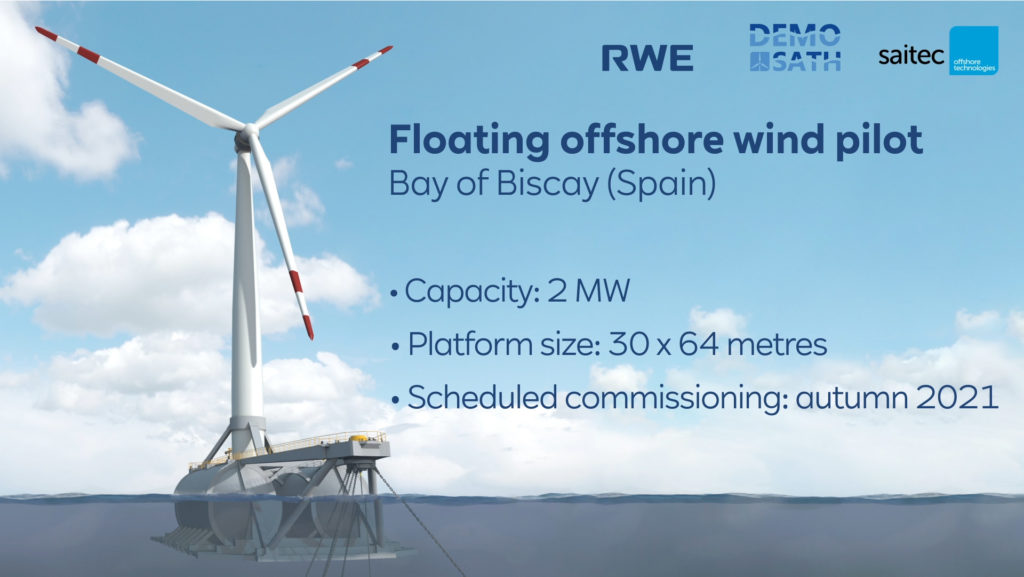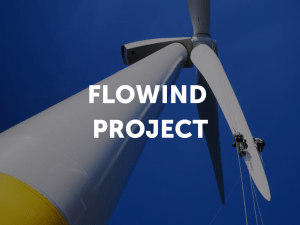- SATH-Technology promises cost benefits in future floating offshore market
- DemoSATH, a concrete platform hosting a 2 MW turbine, is scheduled for commissioning in autumn 2021
RWE Renewables and Saitec Offshore Technologies have joined forces to test new ways to affordably install and operate offshore wind farms in deep waters. In a joint pilot project called “DemoSATH”, the RWE subsidiary specialising in renewable energy and the Spanish engineering company Saitec Offshore Technologies will start testing a floating platform for wind turbines off the Basque Coast in 2021.
SATH technology is based on a twin hull made of modularly prefabricated and subsequently braced concrete elements. The float can align itself around a single point of mooring according to the wind and wave direction. The objective of the project is to collect data and gain real-life knowledge from the construction, operation and maintenance of the unit. The pilot project will last 3.5 years: 18 months for the planning and construction of the plant, followed by a two-year operating phase.
RWE Renewables CEO Anja-Isabel Dotzenrath declares, ”We see great potential for floating wind farms worldwide. Especially in countries with deeper coastal waters, this opens up attractive opportunities. With DemoSATH, we are gaining experience with an innovative concrete-based platform technology that will help us to position ourselves in this growth market.”
Saitec Offshore’s COO Luis González-Pinto states: “The potentiality of SATH to reduce the cost of floating wind is immense. Now is time to build and operate this floating wind turbine and widen this exciting market”. Collaboration between both companies is seen as highly beneficial, as he explains: “This is an agreement between a well-established player in offshore wind, and a young innovative company. We are confident that this combination can provide massive gains for both parties”.
RWE Renewables will finance part of the project costs, contribute its many years of offshore experience, and gain access to the resulting findings in return. The focus is on the performance and on the load behavior of the platform under all possible conditions. In addition, the partners are interested in operational experience, which is essential for the planning of future commercial wind farms. Among the things to be tested are safe and efficient solutions for vessel accessibility to the platform and for the replacement of large components. In order to be able to flexibly adapt offers for offshore wind farms worldwide to local conditions, RWE is testing other technological options for Floating Offshore in addition to SATH.
DemoSATH
will be Saitec Offshore’s second project in open waters. In April 2020 the
deployment of a scaled 1:6 model off the Coast of Santander is scheduled. For
the DemoSATH project, Saitec Offshore Technologies provides the design and
Project Management during the whole lifecycle of the development. The company is
also managing the operation, maintenance and data treatment during the testing.
This enables Saitec Offshore Technologies to capture improvement and
optimisation opportunities throughout all phases.
For
the large prototype, the structure and the 2 MW wind turbine will be
assembled in the port of Bilbao. The base of the structure will be approx. 30
metres wide and approx. 64 metres long. The platform including the turbine will
be towed to its anchorage point in a test field (BIMEP)
2 miles off the coast. The sea is about 85 metres deep at this point. Hybrid
mooring lines, composed by chains and fibre, anchored to the seabed will hold
the floating body in position. The plant is expected to go into operation in
the third quarter of 2021. The electricity generated during the project will be
fed into the Spanish power grid.





